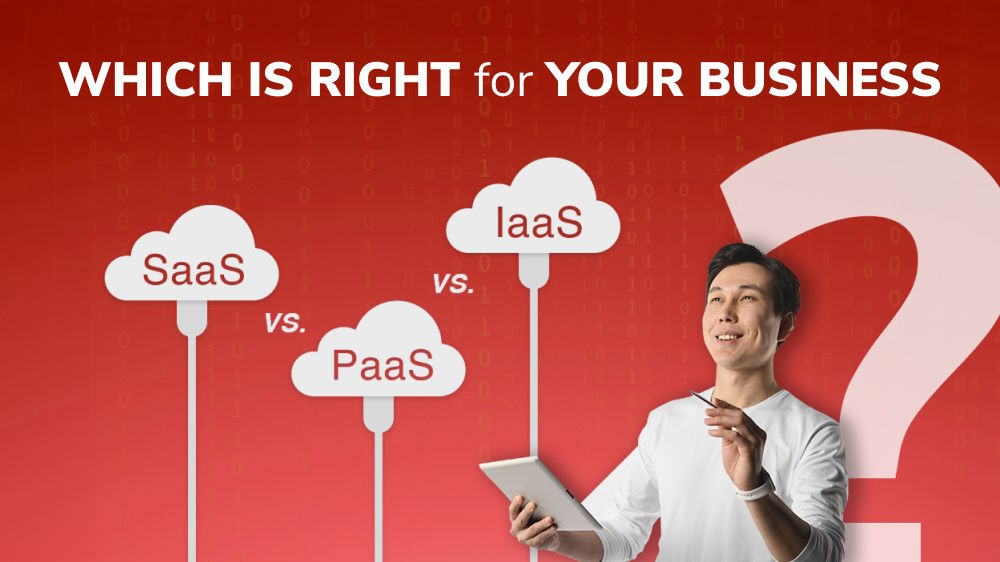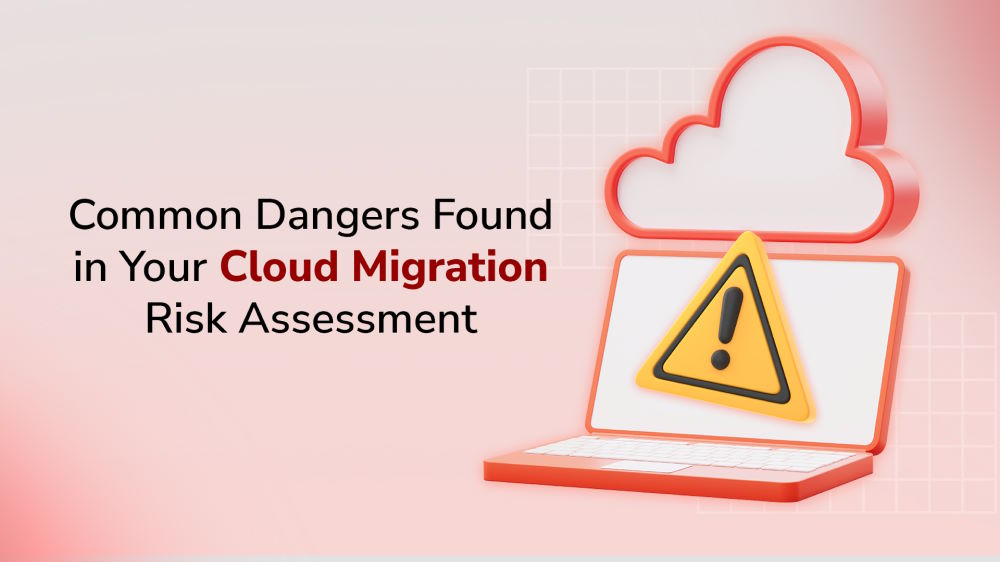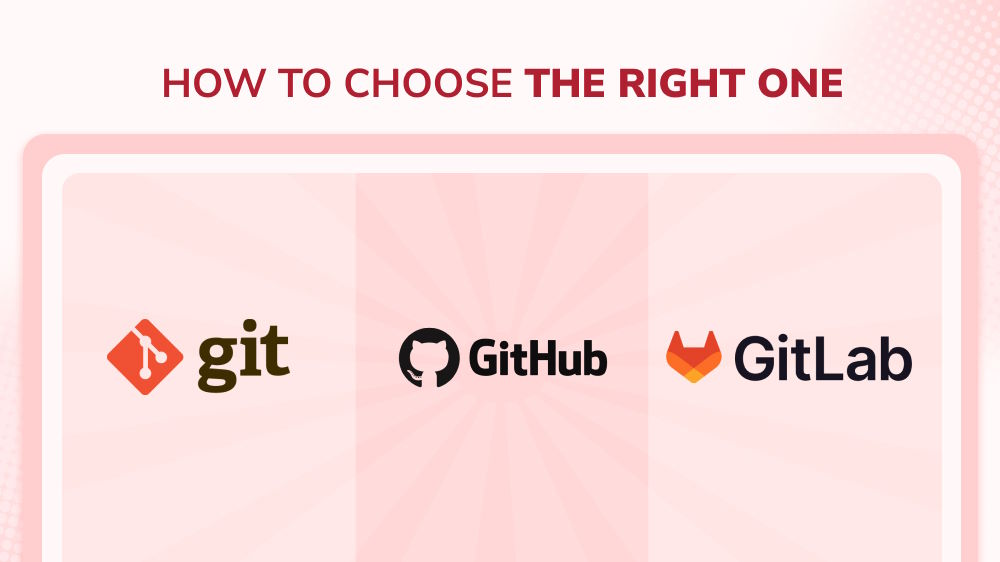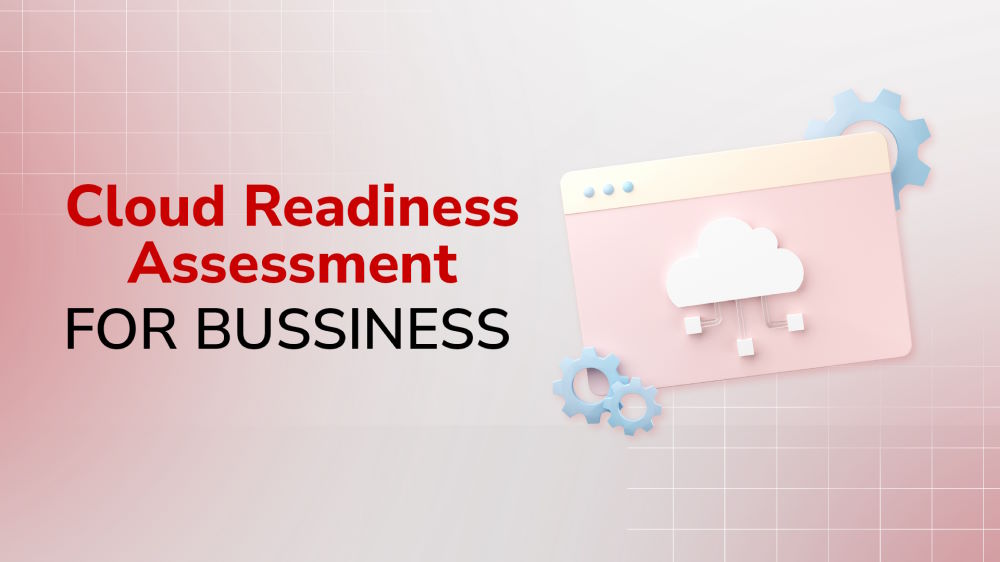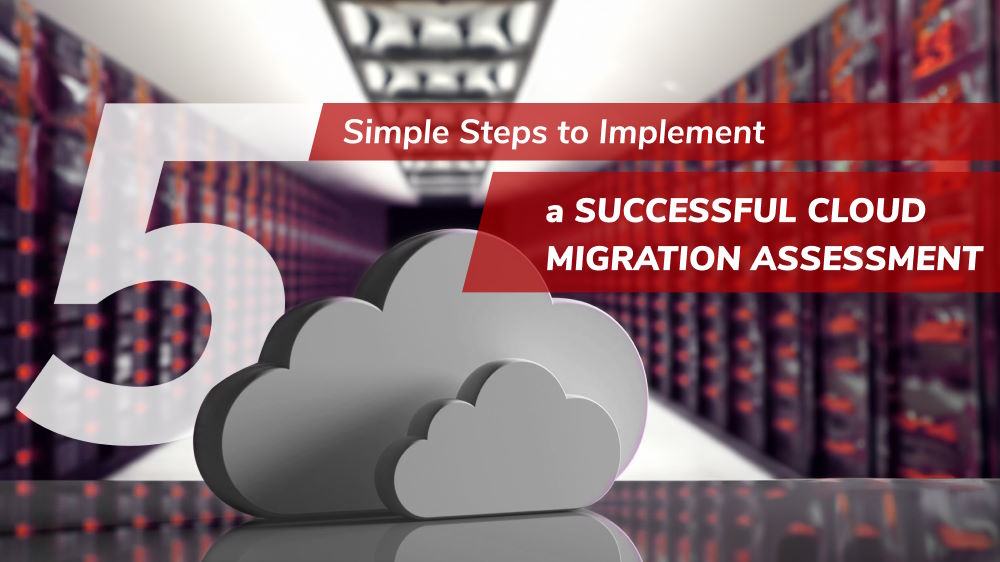
The True Cost of Cloud Computing: 2025 Pricing Breakdown
Think cloud computing saves you money? It can, but only if you understand how the costs really work.

Content Map
More chaptersCloud computing is more than mere data management technology; it is an essential business strategy. O-Reily reported that 90% of businesses indicated that they are using the cloud. It comes with a myriad of attractive perks: Saved costs on infrastructure, data backup and recovery solutions, flexibility, and scalability.
Getting started with cloud computing, however, can be overwhelming. Organizations offer numerous plans, tiers and models for their users. Where does one even begin to determine what is suitable for one’s business needs?

Worry not, as this article will help you cover the complexities of cloud computing costs, including the factors that play into the final price, the models you need to know, and a comprehensive comparison of the major cloud providers. Let’s begin.
Key Takeaways:
- Cloud computing costs are affected by numerous factors, including storage, networking, and computing. However, it’s important to keep in mind the more hidden ones, too, like exit fees or data overage fees.
- Pricing models and cloud service type – IaaS, PaaS, and SaaS can have a significant impact on how you budget and save costs.
- Each cloud provider brings its own pricing structure, perks, and limitations, so understanding what fits your technical needs and budget is key to making the most out of your cloud investment.
- Optimizing cloud costs starts with full visibility into your resource usage and continues with treating cost as a key metric that’s shared, tracked, and acted on across teams.
Factors Affecting Cloud Computing Costs
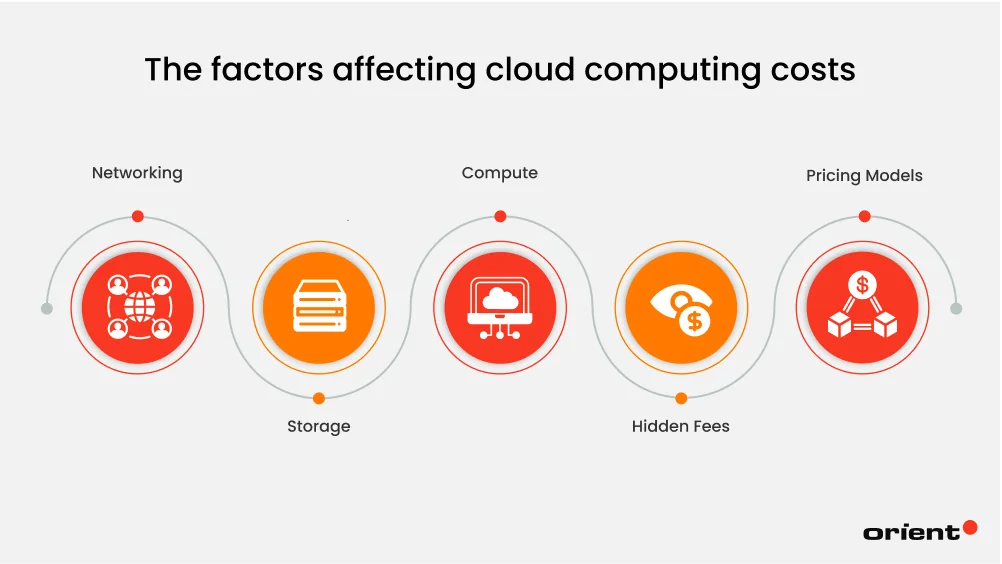
Understanding the factors that affect cloud computing costs enables you to manage financial budgets effectively and maximize profits on your investments.
Networking
Networking refers to the data transfer between the clouds, across different regions and zones. This also includes network security features. Networking costs stem from load balancing, bandwidth usage, VPNs, or the use of specific gateways for connections. The cost can quickly snowball if your organization operates internationally and requires comprehensive data movement.
Storage
Cloud storage is a set of resources that comes with every cloud service, involving the storage place itself (in data centers or machineries), the data retrieval, and a predetermined IOPS (input/output operations per second). In addition to the amount of data stored, other elements that play a direct role in the price of storage include:
- Storage class: standard, infrequent, or archive.
- Durability
- Access frequency
- Geographic redundancy
Compute
Compute is a broad term referring to the essential resources the provider offers, including CPUs, RAM, GPUs, containers, serverless computing, and virtual machines (VMs). Compute costs vary based on their power, duration of use, size, etc. The prices also differ depending on the pricing models you choose, e.g., computing power scales as your business grows, which we will discuss in more detail later.
Hidden Fees
Networking, storage, and compute are often apparent very early on when researching cloud computing costs. However, those elements aren’t the only ones that make up the prices. Other hidden fees can drive the cost up or down significantly, so businesses need to be aware of them early on.
- Data Overage is one of the most common hidden costs. Most cloud providers give you a fixed volume of storage and data transfer. If you exceed these thresholds, the providers will automatically charge additional fees, often at a much higher rate.
- Exit Fees are also known as data retrieval costs. Vendors might charge you if you decide to migrate data from the clouds and discontinue the services to switch providers, or perhaps work on on-premise solutions. The costs can quickly snowball if the amount of data retrieved is high. Companies need to think about exit fees right from the onboarding days. Discuss with providers the terms relating to exit fees to avoid vendor lock-in, or search for providers that offer data retrieval limits to avoid high hidden costs.
- Region and Availability Zones: Cloud regions refer to specific geographic areas where cloud providers operate their data centers. Each region includes multiple availability zones. These are separate, logical data centers located close to each other within the same region. Each availability zone is isolated from the others to prevent failures from spreading, but they’re interconnected with low-latency networks, allowing for high availability and resilience.
Cloud computing cost structure differs across regions and availability zones. The more international a company’s operational footprint, the higher the costs due to cross-region data transfer.
- Support and Operational Costs: These costs consist of support for network infrastructure and server and related issues, data center amenities, storage warranties, and labor-related fees like training and turnover.
- Licensing Fees: Cloud providers often charge extra for access to SQL databases, servers, or other enterprise tools. These fees can be billed per user, per core, per hour, or even per instance, depending on the agreement with cloud service providers.
Pricing Models
Cloud vendors offer users a variety of pricing models with flexible pricing structures to meet a variety of demands.
On-demand
Also known as a pay-as-you-go model, it is one of the most flexible pricing structures. Without any long-term commitments, companies only need to pay for the cloud resources that they use. This pricing model is most suitable for businesses with a predictable workload that needs to scale up or down quickly. Another huge plus of this pricing model is that there is no need for a large upfront investment. However, consistent high usage of cloud resources can lead to higher expenses overall, so make sure you take this factor into account.
Reserved Instances
This pricing structure is suitable for companies with a steady load and long-running systems, as it involves securing cloud resources for 1 to 3 years. By prepaying and reserving cloud capacity in advance, businesses get a discount of 50 to 75 percent. However, businesses also need to be careful in evaluating their workload, as they might be paying for unused capacities or paying extra during peak loads.
Spot Instances
The cloud computing market is constantly fluctuating. In the spot instances model, businesses can bid for unused cloud capacities, usually at a much lower price (up to 90% discount). The actual prices depend on the supply and demand. However, users can lose access to these resources if demand spikes on very short notice or if the current spot has a higher bidding price. Hence, this kind of cost structure is the most suitable for short-term and non-essential commitment workloads.
Subscription
With the subscription model, you turn cloud computing costs into a recurring monthly, quarterly, or yearly fee. Imagine a subscription model similar to your gym membership fees. This model offers predictable expenses and easy budgeting. You can choose the package that meets your needs in terms of storage, computing power, or other important aspects. However, keep in mind that this model is harder to scale up or down based on current demands, and you are likely paying for unused resources.
3 Types of Cloud Service Models
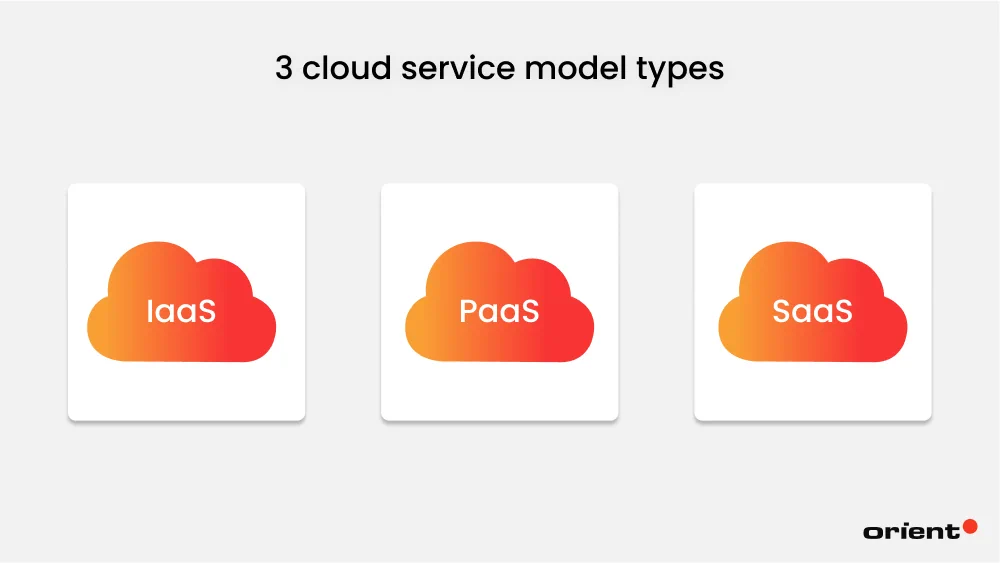
It’s impossible to discuss cloud computing services without discussing its service models. The following service models – IaaS, PaaS, and SaaS – not only dictate how clouds work for an individual or enterprise, but they also play a part in determining the costs.
IaaS
Infrastructure as a service, or IaaS, offers companies pay-as-you-go services, such as renting IT infrastructure like networking, storage, servers, virtualization, etc. While you, the user, are in control of the data and system, the provider handles the infrastructure, like server configuration and maintenance.
IaaS offers businesses a lot of room for flexibility, so this model is suitable for small companies that don’t want to invest in complex hardware or have the right resources for infrastructure management and maintenance.
PaaS
PaaS stands for Platform as a Service. PaaS covers everything IaaS offers, along with a cloud development and deployment environment. Teams can focus on creating, testing, and deploying applications in this environment. Not only does the vendor take care of the infrastructure, but they also ensure you have all the tools to turn your app idea into reality, from databases, middleware, and tools for monitoring and deploying and running applications.
This service is ideal for teams with the goal of creating custom applications.
SaaS
SaaS, or software as a service, covers both PaaS and IaaS functions. Users no longer need to install software on their local devices, but instead can access the software via a web browser. Every aspect of the app is handled by the cloud provider, from infrastructure to updates and bug fixes. SaaS often operates under a subscription-based service.
SaaS is a great choice if your company doesn’t have an in-house team or is working on a short-term project that can benefit from affordable, subscription-based services.
Cost Comparison: Major Cloud Providers (2024–2025)
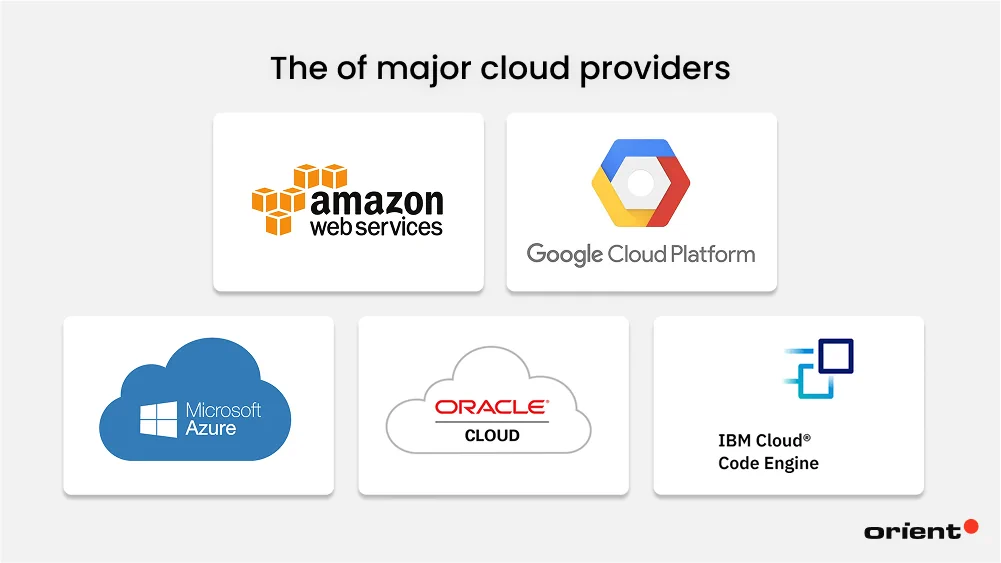
It’s time to take a look at real-life examples – the largest and most well-known cloud providers.
Amazon Web Services (AWS)
AWS is one of the most common cloud services. It offers its customers three pricing models: pay-as-you-go, reserved instances (or, as AWS calls it, “save when you commit”), and volume-based discounts (“pay less by using more”). For new users, AWS offers a Free Tier that includes a full year of popular services, including RDS instances, S3 storage, and EC2 instances. Certain services can be used or tested on a small scale since they are always free. However, ordinary costs could be incurred if the Free Tier limits are exceeded. It is essential to monitor use.
With all the complexity of pricing, companies can estimate their cloud computing costs by using the AWS pricing calculator, AWS Cost Explorer, or AWS Budget. AWS has been extremely successful, thanks to its wealth of over 200 services, affordable prices, and security.
Google Cloud Platform (GCP)
Even though Google Cloud Platform doesn’t boast as large a market share as AWS, it is growing quickly. Similar to AWS, GCP offers its users three pricing models: pay-as-you-go and pre-paying for resources at discounted rates.
Google Cloud offers per-second billing, so you’re only charged for what you actually use, a flexible pricing model that helps avoid unnecessary costs. New users can explore the platform with a 90-day free trial, which comes with $300 in credits. Google also offers a Free Tier, giving you ongoing access to select services like the e2-micro and f1-micro VM instances at no cost. The anticipated monthly cost of an on-demand instance with four virtual CPUs and 16 GB of memory operating 744 hours a month is $99.
Another thing to keep in mind is that Google Cloud isn’t the most beginner-friendly platform. Running an unmanaged instance requires technical expertise, and premium support comes at a steep price. If you’re just getting started with cloud computing, this is something to keep in mind.
Microsoft Azure
Azure is widely trusted by 95% of Fortune 500 enterprises to support their business operations and enterprise-scale requirements. Microsoft Azure offers similar pricing models as AWS and GCP – pay-as-you-go, reserved instances, and spot pricing (in which Azure cloud services offer up to 90% discount on unused computing power. Spot instances are suitable for fault-tolerant applications, stateless applications, and non-urgent workloads.)
Microsoft Azure is known for its unique hybrid capabilities, facilitating easy mobility and reliability between on-premise and public Cloud, with a range of connections including VPNs, caches, CDNs, and ExpressRoute. Seamless integration with other Microsoft tools is another reason many choose this cloud provider. Oracle estimated that approximately $134 is spent each month on a virtual machine instance with four virtual CPUs, 16 GB of memory, and 744 hours of operation.
Oracle Cloud Infrastructure
Oracle Cloud Infrastructure (OCI) was first introduced in 2016. The organization offers several pricing models, including:
- Subscription
- Pay-as-you-go
- Reserved instances
- Oracle Universal Credits: customers can use OCI resources for IaaS and PaaS services, including upcoming cloud services. Credits are taken away proportionally over a year, allowing customers to take on more work and potentially receive discounts based on their purchase.
- Bring Your Own License (BYOL): This feature allows users to use fully automated managed versions of the software or run apps on the high-performance Oracle Cloud Infrastructure.
- Monthly Flex: This model requires a monthly payment.
Even though Oracle joined the market later compared to its counterpart, it has quickly become a top choice for many companies, for its lower prices, high performance, and comprehensive cloud strategies. For example, Oracle Cloud provides Oracle Exadata, a platform specifically optimized for running Oracle Databases and well-suited for high-performance online transaction processing (OLTP) workloads.
IBM Cloud Code Engine
IBM Cloud Code Engine comes with a generous free tier, so you only pay for what you use beyond that limit. Each month, you get 100,000 vCPU seconds, 200,000 GB seconds, and 100,000 HTTP requests at no cost. If your usage goes beyond these thresholds, charges apply based on consumption, e.g., around $0.000034 per vCPU second, $0.0000035 per GB second, and so on.
IBM Cloud pricing depends on your usage, deployment model, and support needs. The platform offers a free tier, along with four flexible pay-as-you-go options. The standard pay-as-you-go model bills you monthly based on actual resource use. If you’re ready to commit to a monthly spend, the Enterprise Savings Plan rewards you with discounts. For long-term planning, IBM Cloud Reservations lets you reserve capacity for one or three years at a lower rate. There’s also a subscription model, where you commit to monthly spending in exchange for tiered discounts. The more you commit, the more you save.
Quick Comparison
| Provider | Number of Data Centers | CPU | GPU Type | Pricing Models |
|---|---|---|---|---|
| AWS | 34 regions,108 availability zones | 96 | NVIDIA A100 80 GB | Pay-as-you-go Savings Plans Reserved Instances Spot Instances Dedicated Hosts Free Tier |
| GCP | 42 regions, 127 availability zones | 96 | NVIDIA A100 80 GB | Pay-as-you-go Committed Use Contracts Sustained Use Discounts Preemptible VMs Free Tier |
| Azure | 70 regions | 96 | NVIDIA A100 80 GB | Pay-as-you-go Reserved Instances Spot VMs Azure Hybrid Benefit Free Tier |
| Oracle | 45 regions | 256 | NVIDIA A100 80 GB | Pay-as-you-go Monthly Flex (Universal Credits) Bring Your Own License (BYOL) Free Tier |
| IBM | 6 multizone regions | 96 | NVIDIA Tesla V100 | Pay-as-you-go Enterprise Savings Plan Cloud Reservations Subscription Model Free Tier |
Tips for Optimizing Cloud Computing Costs
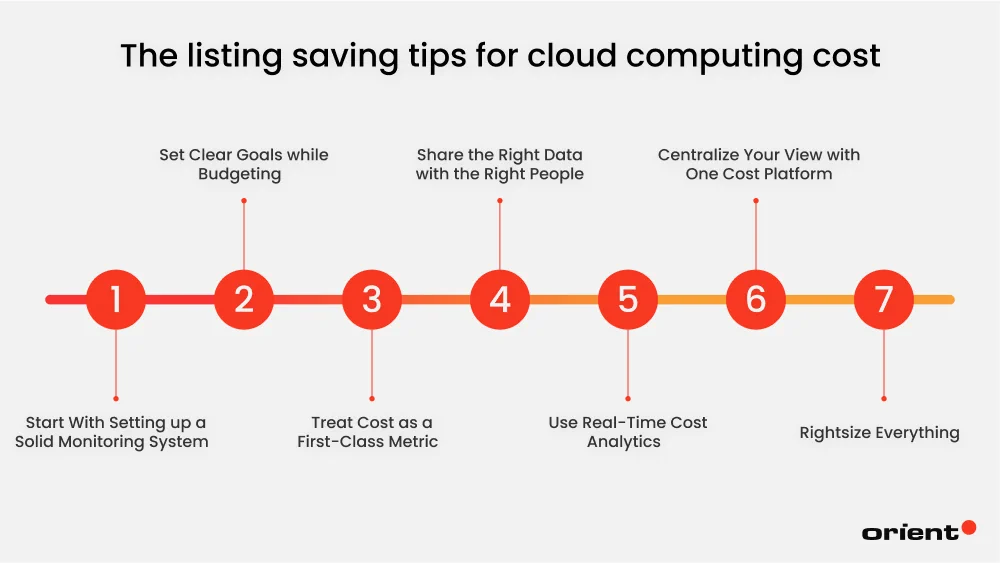
Clouds allow your business to grow and scale quickly without the expensive upfront investments, so it has always been known for its ability to save significant costs. However, understanding what makes up cloud computing costs is only the first step in the cost-saving journey. The next step is mastering how to manage and optimize the benefits of cloud computing without spending heavy funds on it.
Start With Setting up a Solid Monitoring System
You need to gain full visibility into the resources you are paying for. It’s only possible to efficiently manage your funds when you fully understand what resources you are investing in. There are tools for this very goal, like Cloudwatch, Cloud Trail, or Kubecost. Cloud providers also offer their own tracking tools.
Set Clear Goals while Budgeting
Don’t solely focus on the financial concerns. What are the broader business goals? Discuss with your team how you can align the budgeting process with such goals. Collaborate across product, engineering, and finance teams to make cost a shared priority from day one.
Treat Cost as a First-Class Metric
It’s easy to overlook costs when you’re focused on performance, features, and speed. But in a cloud environment, every engineering decision has a price tag. Make sure your team has access to current and measurable cost data. Consider tracking metrics like:
- Unit cost (e.g., cost per API call or report)
- Idle cost (baseline cost with zero user traffic)
- Cost efficiency curve (how costs scale as your user base grows)
By making cost data accessible and actionable, you empower teams to build with both performance and affordability in mind.
Share the Right Data with the Right People
Engineers and finance teams care about cloud costs, but they view it from different angles. Engineers need historical data and detailed breakdowns (e.g., per service or feature) to spot anomalies and optimize usage. Finance teams, on the other hand, are more interested in forecasts, ROI, and monthly projections. Tailor dashboards and reporting tools to each team’s needs so everyone can make informed decisions.
Use Real-Time Cost Analytics
Don’t wait until the end of the month to make financial decisions. Utilize real-time analytics to detect anomalies like unexpected surges to take timely actions, whether it is scaling back to reduce unused and wasted resources or scaling up to support growth.
Centralize Your View with One Cost Platform
Managing multiple dashboards across providers and products creates noise and confusion. What you need is a centralized platform that consolidates your cloud cost data in one place. This makes it easier to analyze trends, track costs per resource, and zoom in on specific issues.
Rightsize Everything
Right-sizing is about finding the sweet spot – not over-or under-provisioning resources. That includes compute, storage, memory, and more. Tools like AWS Trusted Advisor or GCP Recommender can help identify inefficient resources. While the process may take time, it yields long-term benefits in both cost and performance.
Wrapping Up

Calculating and optimizing costs can be a challenging feat. However, with the right and foundational knowledge, you’ll have a strong stepping stone into utilizing the resources and yielding the maximum benefits from the cloud.
Here’s a bonus tip: Partnering with the right provider can make a world of difference. Trusted vendors like Orient Software, a proud Microsoft Azure partner, not only deliver top-tier cloud solutions but also help you unlock exclusive pricing and cost-saving opportunities. That’s smart cloud computing, with better performance and better value, all in one.

